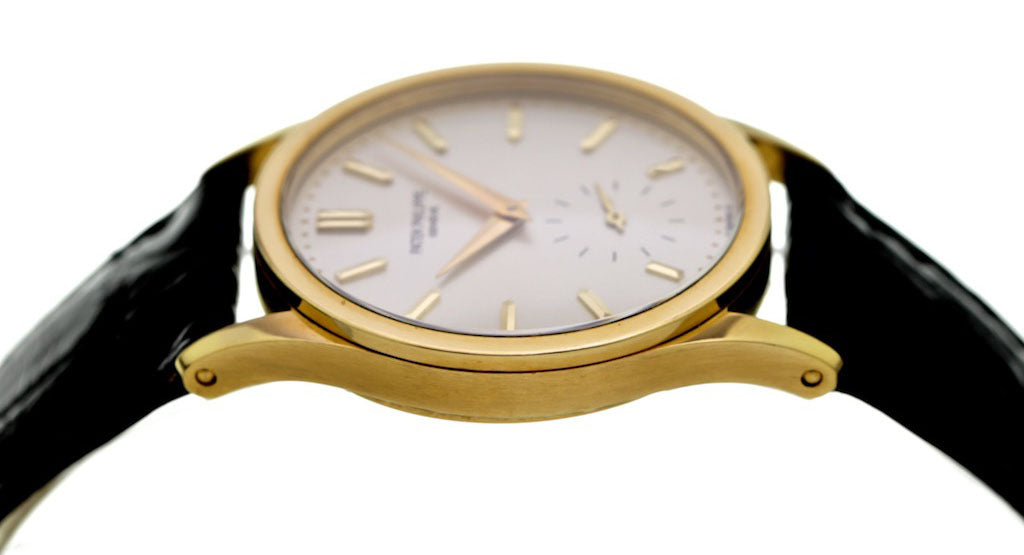Just like any other premium item, the key to prolonging the lifespan of a sophisticated timepiece lies in its proper care. Despite being designed to endure for numerous generations, the assurance of longevity heavily relies on the owner's maintenance practices. Beyond the evident precautions, such as refraining from dropping or striking it forcefully against surfaces, there are additional actions one should steer clear of to ensure the optimal functioning of the watch. Explore the following six practices to avoid, ensuring your timepiece remains in impeccable condition.
1. Protect Your Timepiece: Crown Care for Water-Resistant Watches
Moisture is a serious threat to a watch's inner workings. Many luxury watches today have screw-down crowns for a tight seal against water. Note that screw-down crowns offer better water resistance than pull-out ones.
Regardless of crown type, never extract it underwater to prevent water damage. Even watches like Rolex Oyster, built for underwater use, shouldn't solely rely on this. If you need to adjust the crown, make sure you're on dry land with no water nearby.
Moisture presents a substantial hazard to the intricate mechanisms inside a watch, as even a solitary water droplet can result in substantial damage. To address this risk, numerous modern luxury watches incorporate winding crowns that securely screw into the case, creating an airtight seal. It's important to recognize that screw-down crowns offer enhanced water resistance in comparison to pull-out crowns.
2. Chrono Caution: Keep Pushers Dry!
Typically, chronographs feature two pushers positioned on either side of the winding crown—the upper one to initiate and halt the chronograph hand, and the lower one to reset the hand to zero. Pressing these buttons beneath water, akin to pulling out the crown, can result in water infiltrating the watch.
While there are occasional exceptions—for instance, the Blancpain Fifty Fathoms Chronograph and Omega Seamaster Professional Chronograph, which can be operated at depth—in general, it is advisable to refrain from engaging the chronograph pushers when submerged.
3. Wristwatch Wisdom: Unclasp Before Adjusting!
Setting a watch while it's already being worn is a common error made by many individuals. Often, the need to modify the time, date, or wind the movement becomes apparent only after putting on the watch. However, this practice carries risks, as applying excessive pressure to the winding stem can lead to its breakage, particularly when the watch is on your wrist. This risk is particularly pertinent with older or vintage timepieces.
It’s always safer to remove the watch from your wrist before making any adjustments. And if you want to be super careful, place something soft under your watch (like a plush towel) to soften the landing in case it slips out of your hands.
4. Complication Caution: Stay Out of the Red Zone!
Avoid making adjustments to your watch's calendar functions between 9 P.M. and 3 A.M., known as the red zone. This critical period can disrupt the gears responsible for changing calendar displays. If adjustments are necessary, set the time to a safe hour like 6:30 before making changes and reset the hands afterward. Rolex watches lack a designated "danger zone," but it's wise to exercise caution and assume a potential risk period.
5. Magnetic Menace: Shield Your Watch!
Apart from water exposure, magnetism poses a significant threat to the precision of a watch movement. Magnetic influences can lead to erratic timekeeping, causing the movement to run too fast, too slow, or even come to a halt. Resolving such issues necessitates a visit to a watchmaker for recalibration. It's essential to note that it's not only x-ray machines that should be avoided; everyday items like smartphones, tablets, computers, magnetic closures on handbags, speakers, and similar objects can also magnetize your watch.
When leaving your watch on your nightstand overnight, ensure it's not placed near any devices emitting magnetic fields. A simple method to check for magnetization is to position your watch close to a compass. If the compass needle moves in proximity to your watch, it indicates magnetization.
It's noteworthy that certain brands provide anti-magnetic watches, like the Rolex Milgauss and newer METAS-certified Omega models. However, if you're uncertain about your watch's anti-magnetic properties, it's advisable to err on the side of caution and keep it away from potential magnetic fields.
6. Power Play: Don't Let Your Watch Battery Linger Depleted!
When your quartz watch's battery is exhausted, reconsider the practice of letting it linger in a drawer for an extended duration. Allowing a dead battery to remain inside the watch for an extended period may result in acid leakage, causing irreparable or costly damage to your timepiece. Therefore, when you observe that your quartz watch has run out of power, promptly replace the battery. Even a quartz Rolex is susceptible to damage from battery acid.
Additional Tip: Nab Your Dream Watch Without Overpaying!
It's widely known that some luxury watches fetch prices in the secondary market that exceed their original retail value. It's not unusual to encounter specific models from brands like Rolex, Patek Philippe, Audemars Piguet, and Richard Mille trading well beyond their initial sticker prices.




